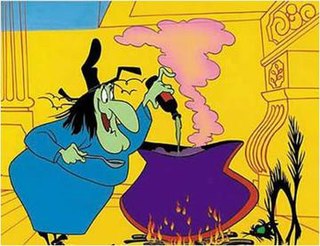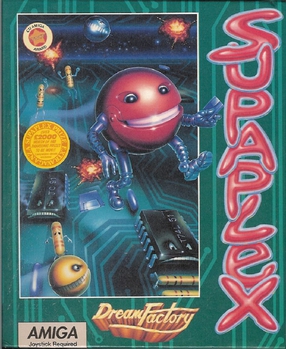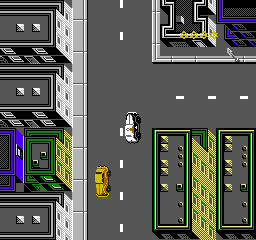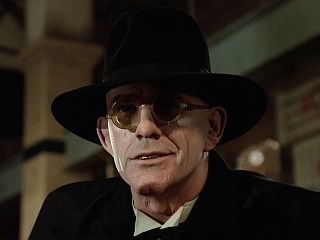
Who Framed Roger Rabbit is a 1988 American fantasy comedy film directed by Robert Zemeckis from a screenplay written by Jeffrey Price and Peter S. Seaman. It is loosely based on the 1981 novel Who Censored Roger Rabbit? by Gary K. Wolf. The film stars Bob Hoskins, Christopher Lloyd, Stubby Kaye, Joanna Cassidy, and the voices of Charles Fleischer and an uncredited Kathleen Turner. Combining live-action and animation, the film is set in an alternate history Hollywood in 1947, where humans and cartoon characters co-exist. Its plot follows Eddie Valiant, a private investigator with a grudge against toons, who must help exonerate Roger Rabbit, a toon framed for murder.

Witch Hazel is an animated cartoon character in the Warner Bros. Looney Tunes and Merrie Melodies series of cartoons and TV shows. Witch Hazel is a fairy tale witch antagonist with green skin, a round figure, bulbous facial features, and a single tooth. The name is a pun on the witch-hazel plant and folk remedies based on it.

Who Censored Roger Rabbit? is a fantasy mystery novel written by Gary K. Wolf in 1981. It was later adapted by Disney and Amblin Entertainment into the critically acclaimed 1988 film Who Framed Roger Rabbit.

Alice in Wonderland is a 1951 American animated musical fantasy comedy film produced by Walt Disney Productions and released by RKO Radio Pictures. It is based on Lewis Carroll's 1865 novel Alice's Adventures in Wonderland and its 1871 sequel Through the Looking-Glass. The production was supervised by Ben Sharpsteen, and was directed by Clyde Geronimi, Wilfred Jackson, and Hamilton Luske. With the voices of Kathryn Beaumont, Ed Wynn, Richard Haydn, Sterling Holloway, Jerry Colonna, Verna Felton, J. Pat O'Malley, Bill Thompson, and Heather Angel, the film follows a young girl Alice who falls down a rabbit hole to enter a nonsensical world Wonderland that is ruled by the Queen of Hearts, while encountering strange creatures, including the Mad Hatter and the Cheshire Cat.

Supaplex is a video game created by Philip Jespersen and Michael Stopp, two Swiss students, and published by Digital Integration in 1991. It is an extended clone of Boulder Dash.
The Bugs Bunny Crazy Castle is a 1989 puzzle video game developed by Kemco for the Nintendo Entertainment System. In 1990, it was released with the same title for the Game Boy in North America and Europe. In Japan, it was released for the Disk System as Roger Rabbit, and then for the Game Boy as Mickey Mouse.

Dick Tracy appeared in the following video game tie-ins for the motion picture:

Mickey's Toontown is a themed land at Disneyland and Tokyo Disneyland, two theme parks operated by Walt Disney Parks & Resorts and The Oriental Land Company respectively. At Tokyo Disneyland, this land is named Toontown. A similar land existed at the Magic Kingdom until 2011 and was named Mickey's Toontown Fair. Walt Disney Studios Park in Disneyland Paris has a related land called Toon Studio.

Judge Doom is a fictional character and the main antagonist in the 1988 film Who Framed Roger Rabbit, portrayed by Christopher Lloyd. He is depicted as the much-feared, cruel, and evil judge of Toontown, who later in the film is revealed as the mastermind behind the framing of the titular character and the murder of protagonist Eddie Valiant's brother.

The Crazy Castle series is a platform game series created by Kemco and released on the Famicom Disk System, Nintendo Entertainment System, Game Boy, Game Boy Color, and Game Boy Advance. It stars different popular cartoon characters, most notably the Warner Bros. cartoon character Bugs Bunny, the Walt Disney cartoon character Mickey Mouse and the Universal cartoon character Woody Woodpecker.

Roger Rabbit's Car Toon Spin is a dark ride located at the Disneyland and Tokyo Disneyland theme parks, based on the 1988 Disney/Amblin film Who Framed Roger Rabbit. Both versions of the attraction are located in Mickey's Toontown. The Disneyland version opened on January 26, 1994, a year after the Mickey's Toontown area opened, and the Tokyo Disneyland version opened on April 15, 1996. In December 2021, the Disneyland version was updated to include a new plot element of Jessica Rabbit in the role of a detective who is determined to stop a crime wave in Toontown.

The Addams Family is a platform game based on the 1991 film of the same name and developed and published by Ocean Software. It was released for home consoles such as the Super Nintendo Entertainment System, computers such as the Amiga, and handheld consoles like the Game Boy.

Imogen is a computer game released in 1986 for the BBC Micro. It was written by Michael St Aubyn and published by Micro Power. It was reissued as the lead game of Superior Software / Acornsoft's Play It Again Sam 5 compilation in 1988 when it was also converted for the Acorn Electron. It is a platform game featuring puzzles.

Mean Streets is a graphic adventure game developed and published by Access Software for MS-DOS in 1989 exclusively in North America. It was ported to the Commodore 64, Atari ST, and Amiga in 1989 and 1990 by The Code Monkeys. Atari ST and Amiga ports were only released in Europe. The game, set in a dystopian cyberpunk neo-noir world, is the first in the series of Tex Murphy mysteries; its immediate sequel is Martian Memorandum. In 1998, Mean Streets was remade as Tex Murphy: Overseer.

Who Framed Roger Rabbit is a media franchise owned by The Walt Disney Company and Amblin Entertainment, that began with the 1988 film, Who Framed Roger Rabbit, itself based on a book titled Who Censored Roger Rabbit? by Gary K. Wolf.

Who Framed Roger Rabbit is a video game based on the film of the same name for DOS, Amiga, Atari ST, Apple II, and Commodore 64. It was released by Buena Vista Software in 1988.

Alice in Wonderland is a 1949 French film based on Lewis Carroll's 1865 fantasy novel Alice's Adventures in Wonderland. Directed by Dallas Bower, the film stars Carol Marsh as Alice, Stephen Murray as Lewis Carroll, and Raymond Bussières as The Tailor. Most of the Wonderland characters are portrayed by stop-motion animated puppets created by Lou Bunin.
Jessica Rabbit is a fictional character in the novel Who Censored Roger Rabbit? and its film adaptation, Who Framed Roger Rabbit. She is depicted as the human toon wife of Roger Rabbit in various Roger Rabbit media. Jessica is renowned as one of the best-known sex symbols in animation. She is remembered for the line: "I'm not bad, I'm just drawn that way."
The Roger Rabbit shorts are a series of three animated short films produced by Walt Disney Feature Animation from 1989 to 1993. They feature Roger Rabbit, the animated protagonist from Who Framed Roger Rabbit (1988), being enlisted the task of caring for Baby Herman while his mother is absent, resulting in a plot defined by slapstick humor and visual gags. Each short concludes with a sequence involving live-action and animation, where the characters interact with live-action human beings, akin to the 1988 film. Droopy Dog from MGM makes a cameo in all of the shorts.

Roger Rabbit is a fictional animated anthropomorphic rabbit. The character first appeared in author Gary K. Wolf's 1981 novel, Who Censored Roger Rabbit? In the book, Roger is second banana in a popular comic strip, "Baby Herman". Roger hires private detective Eddie Valiant to investigate why his employers, the DeGreasy Brothers, have reneged on their promise to give Roger his own strip. When Roger is found murdered in his home, Valiant sets out to look for the killer, with the help of Roger's "doppel".

















